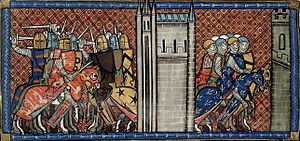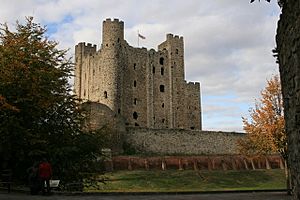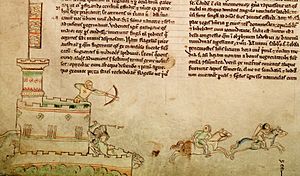First Barons' War facts for kids
Quick facts for kids First Barons' War |
|||||||
|---|---|---|---|---|---|---|---|
| Part of the Capetian–Plantagenet rivalry | |||||||
 King John of England (left) in battle with the troops of Louis of France (right) |
|||||||
|
|||||||
| Belligerents | |||||||
|
Supported by: |
|||||||
| Commanders and leaders | |||||||
|
|||||||
The First Barons' War was a civil war in England that lasted from 1215 to 1217. It involved a group of powerful landowners, called barons, who fought against King John. The war started because King John had lost many battles against King Philip II of France. This led to the fall of his large empire. Also, King John refused to follow the rules of the Magna Carta, a very important document he had agreed to on June 15, 1215.
The rebellious barons, led by Robert Fitzwalter, felt King John was too difficult. They asked Louis, the son of King Philip, for help. In 1216, Louis sailed to England with an army. His father and the Pope did not approve. The Pope even removed Louis from the Church (excommunicated him). Louis captured Winchester and soon controlled more than half of England. The barons in London called him "King of England," but he was never officially crowned.
Louis's plan to rule England changed when King John died in October 1216. Many rebellious barons then left Louis. They decided to support John's nine-year-old son, Henry III. The war continued, but Louis's army was finally defeated at the Battle of Lincoln on May 20, 1217. Later, a French fleet bringing more soldiers was defeated near Sandwich on August 24, 1217. This forced Louis to make peace. He signed the Treaty of Lambeth and gave up the castles he still held. The treaty meant Louis agreed he was never the true king of England. This ended the civil war and the French left England.
Contents
Why the War Started
In June 1215, King John was forced to agree to "The Articles of the Barons." This was a list of demands from powerful barons. They were tired of John's poor leadership and unfair rule. The King's official seal was put on the document on June 15, 1215. In return, the barons promised to be loyal to King John again on July 19, 1215. A formal document, the original Magna Carta, was created on July 15 to record this agreement. One key idea of Magna Carta was that "the law of the land" was more important than the king's personal wishes.
The Magna Carta of 1215 included rules that were supposed to limit the king's power. For example, Clause 61, called the "security clause," allowed 25 barons to overrule the king using force. This was a medieval legal idea, but it had never been used against a king before. After a few months of trying to talk things out in the summer of 1215, open fighting began between the rebel barons and the king's supporters.
Key Events of the War
French Help Arrives
The war started because of Magna Carta, but it quickly became a fight for who would be the next king of England. The rebel barons needed help against King John. They asked Louis, the son of King Philip II of France. Louis was also the grandson-in-law of King Henry II of England. The relationship between England and France was complicated. An old document, the Annals of Waverley, said Louis was invited to invade to stop England from being robbed by outsiders.
At first, in November 1215, Louis only sent some knights to protect London for the barons. But he also agreed to a full invasion. His father and Pope Innocent III tried to stop him. The invasion happened in May 1216. People on the coast of Thanet saw French ships. The next day, King John saw Louis's troops landing in Kent.
King John decided to escape to Winchester. So, Louis faced little resistance as he marched to London. He entered London easily and was welcomed by the rebel barons and citizens. He was called king at St Paul's Cathedral, though he was not crowned. Many nobles, including Alexander II of Scotland, who had lands in England, promised loyalty to Louis.
Many of John's supporters felt things were changing and started to support the barons. One writer, Gerald of Wales, said: "The madness of slavery is over, the time of liberty has been granted, English necks are free from the yoke."
Louis led his army south from London on June 6. He arrived in Reigate the next day and found the castle empty. He moved to Guildford Castle on June 8, which gave up right away. Farnham Castle also surrendered when the French began to attack it. Louis only faced real resistance at Winchester Castle on June 14. But it fell after a ten-day siege. Louis's campaign continued, and by July, about one-third of England was under his control.
Dover Castle Under Siege
Meanwhile, the King of France teased his son, Louis. He said Louis was trying to conquer England without first taking its most important port: Dover. The royal castles at Canterbury and Rochester, along with most of Kent, had already fallen to Louis. However, when Louis reached Dover Castle on July 25, it was ready for a fight. Its leader, Hubert de Burgh, had many soldiers and supplies.
The first siege began on July 19. Louis's men tried to break down the castle gate. But De Burgh's men fought them off. They blocked the broken parts of the walls with large pieces of wood. After the siege, the weak northern gate was blocked. New tunnels and gates were built to make the castle stronger. At the same time, a group of archers from the Weald led by William of Cassingham kept attacking Louis's forces in Kent.
After three months of attacking the castle, Louis had many soldiers tied up there. He called a truce on October 14 and soon went back to London.
Attacks on Windsor and Rochester
Besides Dover, the only other castle that held out against Louis was Windsor. Sixty loyal knights survived a two-month siege there. The castle's lower walls were badly damaged. King Henry III repaired them in 1216 and made the defenses even stronger.
In 1206, King John had spent money to repair Rochester Castle. He had even held it himself during the talks before Magna Carta. But the Charter's rules made him give it back to Stephen Langton, the Archbishop of Canterbury, in May 1215. The rebel barons then sent soldiers to the castle. Its leader, Reginald de Cornhill, opened the gates to them. So, in October 1215, as John marched from Dover to London, he found Rochester in his way. He began attacking it himself on October 11.

The rebels expected more soldiers from London. But John sent fire ships to burn the city's bridge over the Medway River. Robert Fitzwalter rode out to stop the king and fought on the bridge. But he was eventually forced back into the castle. John also attacked the cathedral. He took valuable items and kept his horses inside it. This was to insult Archbishop Langton.
Then, five siege engines were set up. Workers also dug tunnels to weaken the castle walls. By one of these methods, the king's forces entered the outer part of the castle in early November. They then tried the same tactics against the main tower, including digging under its south-eastern corner. The tunnel roof was held up by wooden supports. These were then set on fire using pig fat. On November 25, 1215, John had sent a message saying, "Send to us with all speed by day and night, forty of the fattest pigs of the sort least good for eating so that we may bring fire beneath the castle." The fire caused one entire corner of the main tower to fall down. The rebels moved behind another wall inside the tower but still held out. A few were allowed to leave the castle. But John ordered their hands and feet to be cut off as a warning.
Winter was coming, and the castle was taken on November 30 because the defenders ran out of food, not by force. John set up a memorial to the pigs and a gallows. He wanted to hang all the soldiers who had defended the castle. But one of his captains, Savari de Mauléon, convinced him not to. He argued that hanging those who surrendered would set a bad example if John ever had to surrender. Only one person was hanged, a young archer who had worked for John before. The rest of the rebel barons were taken away and put in royal castles, like Corfe Castle. A writer from the time said, "No one alive can remember a siege so fiercely pressed and so manfully resisted." He also wrote that after it, "There were few who would put their trust in castles."
King John's Death
On October 18, 1216, King John got sick with dysentery. This illness eventually killed him. He died at Newark Castle in Nottinghamshire. With his death, the main reason for the fighting ended. Louis now seemed more of a threat to the barons than John's nine-year-old son, Henry.
Pierre des Roches, the Bishop of Winchester, and several barons quickly had young Henry crowned as King of England. London was controlled by Louis, so it could not be used for the crowning. Instead, on October 28, 1216, they brought the boy from Devizes castle to Gloucester Abbey. A representative from the Pope, Guala Bicchieri, was there. They crowned Henry with a gold necklace.
On November 12, 1216, Magna Carta was reissued in Henry's name. Some parts were left out, including clause 61. The revised document was sealed by the young king's regent (a person who rules for a child king), William Marshal. A large part of the country was loyal to Louis. But the southwest of England and the Midlands supported Henry. Marshal was highly respected. He asked the barons not to blame young Henry for his father's mistakes. Many people felt it was wrong to take away a boy's right to inherit the throne. Marshal also promised that he and the other regents would rule according to Magna Carta. He also got support from the Pope, who had already removed Louis from the Church.
Louis's Losses
William Marshal slowly convinced most barons to switch their loyalty from Louis to Henry. They began to attack Louis. The two sides fought for about a year. On December 6, 1216, Louis took Hertford Castle. But he allowed the defending knights to leave with their horses and weapons. He then took Berkhamsted Castle in late December. Again, he allowed the royal soldiers to leave honorably with their horses and weapons.
By early 1217, Louis decided to return to France for more soldiers. He had to fight his way to the south coast through areas loyal to Henry. He lost some of his soldiers in an ambush at Lewes. The rest were chased to Winchelsea and were saved from starvation only when a French fleet arrived.
Since the truce with Dover, the Dover soldiers had often stopped Louis's messages to France. So Louis sailed back to Dover to start a second siege. The French camp outside Dover Castle was attacked and burned by William of Cassingham and Oliver fitz Regis. This happened just as the ships carrying more soldiers arrived. Louis was forced to land at Sandwich and march to Dover. He began a serious second siege on May 12, 1217. This new siege used up so many of Louis's soldiers. This allowed Marshal and Falkes de Breauté to attack and defeat the pro-Louis barons at Lincoln Castle. This happened on May 15 or May 20, 1217, in what became known as the Second Battle of Lincoln.
Marshal then prepared to attack London. Meanwhile, Louis suffered two more big defeats at sea. These were the Battle of Dover and Battle of Sandwich in the Straits of Dover. These battles were fought by William's friend and Dover's leader, Hubert de Burgh. Louis's new group of ships bringing more soldiers, led by Eustace the Monk, was destroyed. This made it almost impossible for Louis to keep fighting.
The End of the War
After a year and a half of war, most of the rebellious barons had changed sides. This, along with the French defeats in 1217, forced Louis to talk about peace. A few of Henry's supporters wanted Louis to surrender completely. But the Earl of Pembroke successfully argued for more fair terms.
The Treaty of Lambeth was signed on September 11, 1217. In it, Louis had to give up his claim to be the King of England. He also had to agree that he had never been the true king. The main parts of the treaty were that English rebels would not be punished. But the barons who had joined Louis had to pay the French prince 10,000 marks to make him leave faster. Louis gave up the few castles he still held. He also told his allies, Scottish and Welsh soldiers under Alexander II and Llywelyn the Great, to stop fighting. Louis also promised not to attack England again.
Places to Visit
- "The 1216 Experience" at Dover Castle tells the story of the two sieges and the Battle of Sandwich. There is also information about them at the town museum.
- Rochester City Museum has a model of the castle's main tower during the siege.
See also


